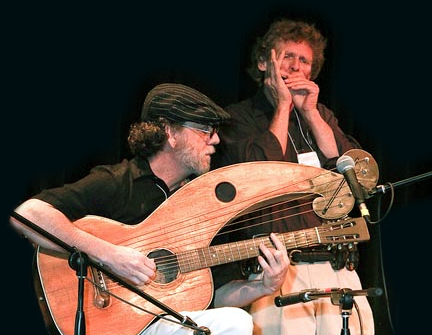
I first met Bad Drew Baldwin when we featured him (with his occasional partner, Juke Joint Johnny) at the 7th Harp Guitar Gathering in 2009 (at left). His reputation had preceded him, but he had to be seen to be appreciated. An iconic bluesman, songwriter, comedian and natural harp guitar player all rolled into one. We’ve always since enjoyed the chance to see him again over the years, most recently last month at HGG17 in North Carolina.
He still plays a vintage Dyer (now a 6-sub-bass; he started with 5), but two years ago he told me of his first instrument, a “four bass Knutsen.” Well, such a thing never existed, so I pestered him for photos, which he eventually dug up. When I asked him for more info, he offered to sit down and tell the story. And just now, he finally did!
Here it is, interspersed with my comments and additional analysis:
Drew: After being introduced to the harp guitar in the late 70’s by the one and only Andy Wahlberg, I knew that this was the instrument I wanted to play. The very next day, I set out on my quest to find a harp guitar of my own. I searched every music store, pawn shop, nook and cranny, but little did I know it would take years before I finally had my first break. I saw an old Knutsen hanging in an antique store and fiddle shop in Tacoma, Washington, where I had recently moved. It was in poor shape, and the owner seemed hesitant to sell it at first, but he could see how badly I wanted it and let me have it for about $300. This was about 1985 (image below).
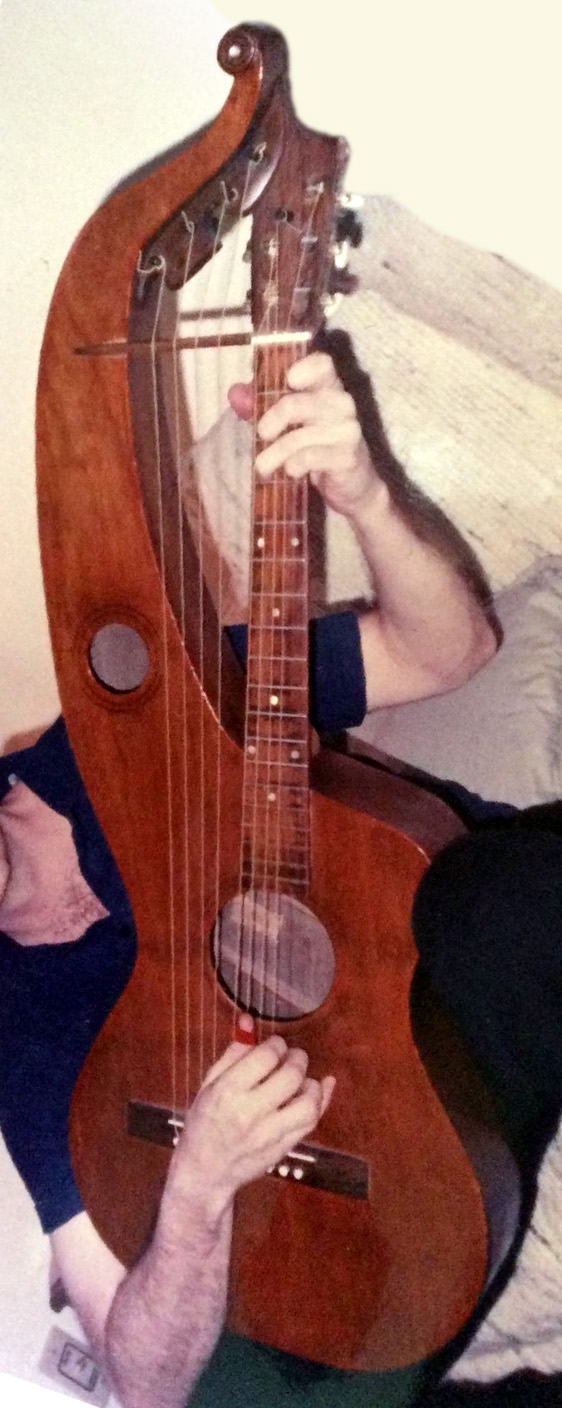
Gregg: The store was “Red’s Fiddle Shop,” which Knutsen expert Dan Most would frequent throughout his life. Dan would send me photos of numerous harp guitars as they came through Red’s shop.)

Drew: I was so excited to get my treasure back home that I forgot to try to buy the picture with “Oscar and the Harp Guitar” he had framed on his wall. I went back to the shop and asked him if I could buy it and he said “sure.” Then he looked over to this guy that was sulking in the corner and said “this is the guy that bought the harp guitar.” The owner had promised him that the next time a harp guitar came into his shop that he could have it. The guy was my soon to be friend, the late Dan Most.
I took Dan to my house and showed him the guitar, and although he wasn’t thrilled that he missed out, he could appreciate how happy I was to have it. We went to his house and he showed me his collection, which I don’t think had a Knutsen harp guitar at the time. This was still long before the internet. We became great friends and went on many vintage guitar hunts together.
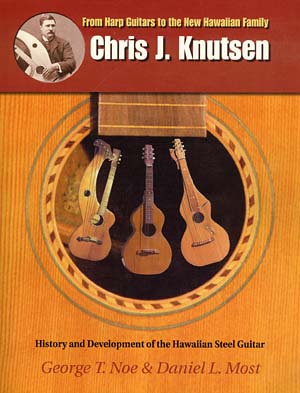 Gregg: Through mutual friend Kerry Char, Dan later became my good friend as well, though we never met. As with Drew, I had my first six Knutsen instruments before Dan got started – though he eventually wound up with at least 30 of them! We shared our findings and theories throughout the 1990s; ultimately, Dan went on to co-author the groundbreaking Knutsen book with Tom Noe in 1999.)
Gregg: Through mutual friend Kerry Char, Dan later became my good friend as well, though we never met. As with Drew, I had my first six Knutsen instruments before Dan got started – though he eventually wound up with at least 30 of them! We shared our findings and theories throughout the 1990s; ultimately, Dan went on to co-author the groundbreaking Knutsen book with Tom Noe in 1999.)
Drew: I moved from Tacoma a couple of years later, and traveled for a while on the vintage guitar show circuit, still looking for more harp guitars while trying to break even buying and selling other instruments. George Gruhn had promised me that he would save for me any Dyer style instruments that came in his shop. I had heard that a Symphony style Knutsen was at Gruhn’s so I went to Nashville expecting to buy it. When I got there, George told me he had just shipped it out to Washington. I asked who bought it and he said “Dan Most.” What could I say? Dan got even! Dan was always such a warm and kind person, and it broke my heart to hear of his passing.
Gregg: Mine, too: https://www.harpguitars.net/knutsen/danmost.htm
Drew: The Knutsen harp guitar in the story is listed in your amazing Knutsen Archives as HGP8, with Don Adams listed as the most recent owner. I performed with this guitar for a few years and it played and sounded pretty good despite its odd construction. I eventually traded it for an awesome c. 1930 Gibson L-1 and it later ended up on eBay.
Gregg: Below, the back view, from the eBay listing.
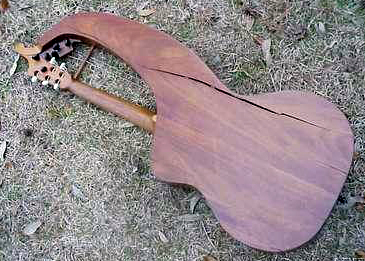
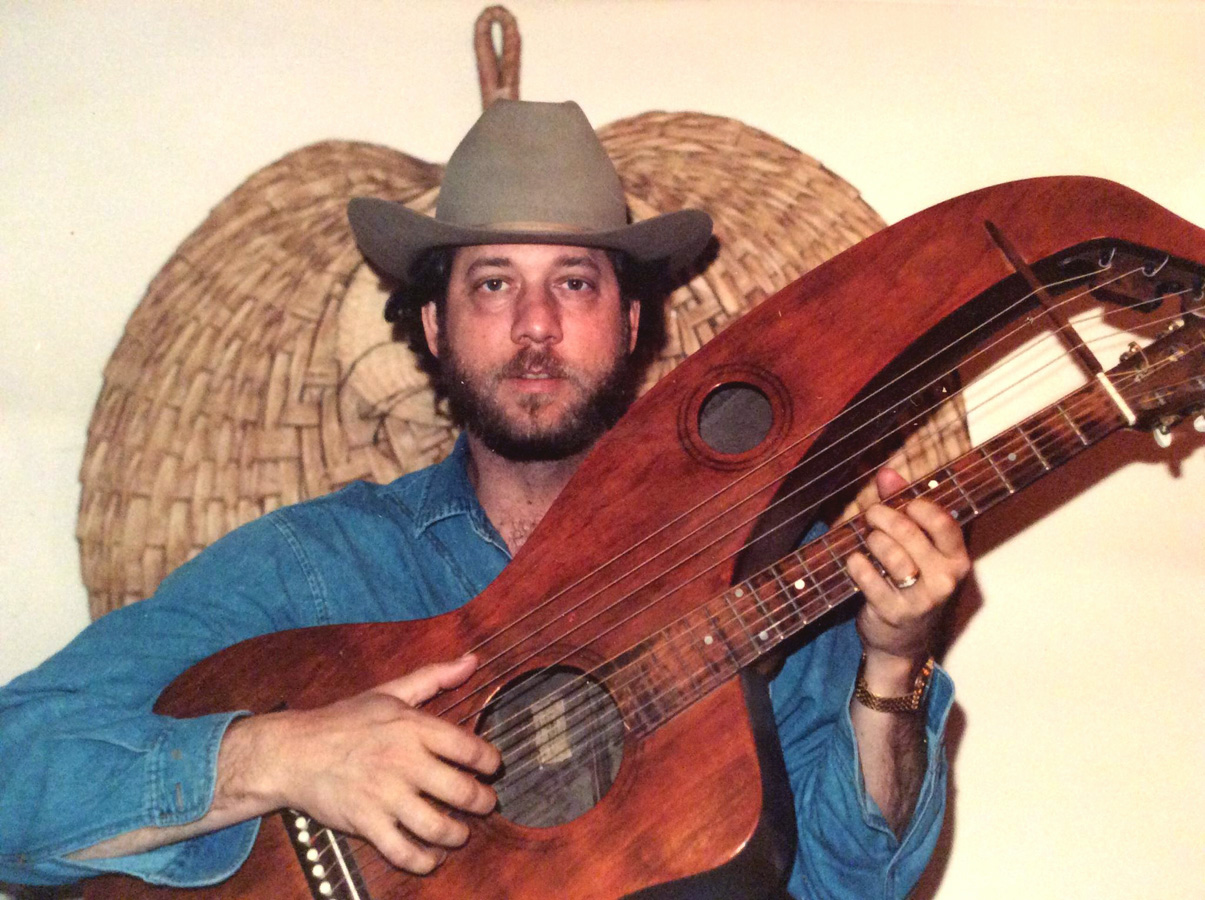 Drew with #HGP8 in the late 1980s.
Drew with #HGP8 in the late 1980s.
Gregg: “HGP8” is its unique Knutsen Archives Inventory number (= Harp Guitar Port Townsend, the 8th specimen from that period/style inventoried).
If the name “Don Adams” sounds familiar, it’s because he once held a key place in harp guitar history. It was Don who started the very first dedicated web site for the instrument back in the year 2000: www.harpguitars.com. He didn’t take it very far (it only had a few pages), and had to let it go after two years. Though he had gifted it to me, URL snipers stole the domain in the split second it went back on the market. Scott Holloway currently owns it.
Drew: Now, you asked me, “Was I sure this originally had 4 bass strings?” Well, no, and maybe. I’m pretty sure the top is not original (it’s a strange wood laminate, and the finish is entirely different.). It also appears that the 10-pin bridge and the wooden bass nut extension are original to the replacement top. But yes, the bass nut is not original and the original nut slot is still there.

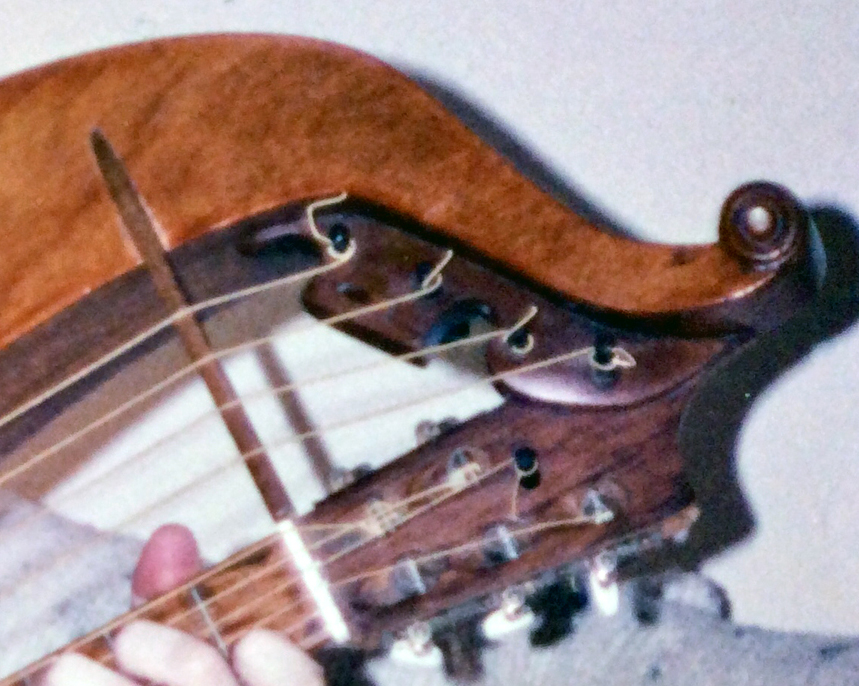
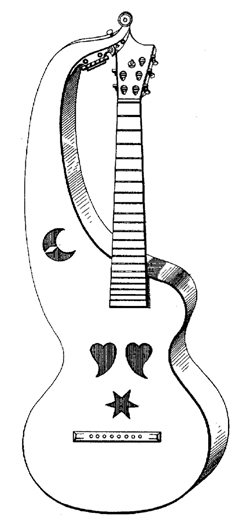
Drew: Well, why would it have a replacement top? At the time I owned it, the only reference I had to a similar-appearing guitar was the patent drawing I found in Bob Hartman’s book, which is referenced in the Archives. I always thought that this guitar may have originally been built as the patent drawing shows, and, considering the moons and stars design “flaw” the top ultimately failed at some point and was replaced. Now, after looking at all of the similar examples in the Archives, the top designs are so similar it makes me wonder if the top was actually replaced by Knutsen, and fitted with the more playable string spacing he used on his subsequent models. Of course, I defer to your vast expertise!
Gregg (from here to end of article): Intriguing speculation, Drew – and with Knutsen, one must always be thinking outside the box!
When I received the first photos of this instrument from Drew last year, I was naturally curious about the four subs – something never seen on this model – but didn’t immediately check it against others. After opening up my HCP8 files, I immediately saw everything Drew was talking about. I had the eBay photos (from the listing he mentions above) and Don’s before and after photos. And now Drew’s earliest incarnation!
Alas, it was not an original 4-bass version, but one modified from an original 5-bass 11-string instrument. At the 17th Harp Guitar Gathering, Drew and I subsequently discussed this at length, after which I again went back through my files.
The bridge is not only a replacement, it is in a new configuration, with four sub-bass pin holes, evenly spaced like the six for the neck. However, all specimens of Knutsen’s 11-string “1898 Patent Style” harp guitars had just nine bridge pin holes. This is because the sub-bass strings were doubled up so that two would share a single hole (presumably to reduce the number of drilled holes to help the integrity of the fragile tops). The highest sub then shared a hole with the neck’s E string (!) This created a tighter cluster of the 5 basses for the right hand. (Knutsen’s similar 9 string models had 8 holes, the E string still sharing its hole with a sub. Incidentally, the U.S. patent clearly shows 5 nut slots for the basses and 8 bridge holes, while the slightly later England patent shows the 9-string configuration.)

Above, an original bridge for Knutsen’s earliest 11-string – the “1898 Patent Style” – showing the configuration that # HGP8 would have originally had. Below, HGP8’s bridge after its early reconstruction where it first had 10 strings (4+6). Subsequently, Don Adams had it further “re-restored” for 11 strings (5+6) by simply inserting the missing first sub-bass into the neck’s E string hole as Knutsen did (seen here). Don didn’t replace the entire bridge as neither of us knew at that time how close to original or not this bridge might have been. (This was only the second one of these seen!)

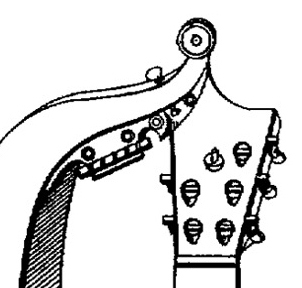
As for the tuners, one needs to first understand Knutsen’s truly bizarre first design for the five subs, which is awkward and impractical in the extreme.
Below I’ll show two other 1898 Patent Style specimens in original condition and configuration.
First is Inv # HGP9, sans bass strings. It is all original, in the exact configuration of the patent illustration. Instead of fitting five perpendicular friction tuners in a row, Knutsen chose to insert one of them sideways through the narrowest part of the hollow arm extension. The friction tuner in the main headstock is for one of the six neck strings, as he could no longer fit a 3-on-a-plate strip on that side! The bass nut is wood, inserted into a slot in the main attachment piece.
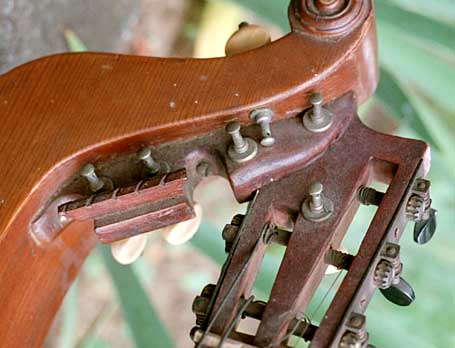
Next pictured is Inv #HGP17, also original and fully strung. Note that the geometry is a little off and the sideways tuner is not between the other two but to the furthest right. The sub-bass attachment piece is shorter so that the next sub-bass tuner sits directly against the headstock. Note the extreme pitch angle these heavy bass strings had to accommodate, and that for basses 1, 2 & 3 one can pretty much choose whichever tuner they like – there’s no good direct shot!
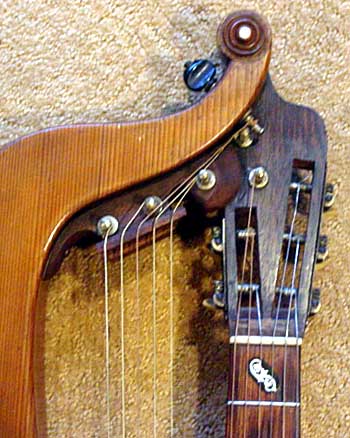
Here’s how this mess looks from the back. But, hey, it works!
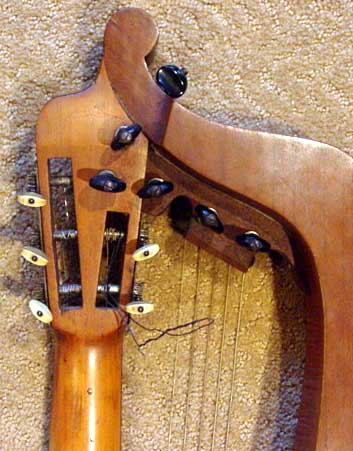
Before we criticize Chris Knutsen too harshly, I should point out that both of these instruments above were likely built by Knutsen’s superior original craftsman, the enigmatic Otto Anderson.
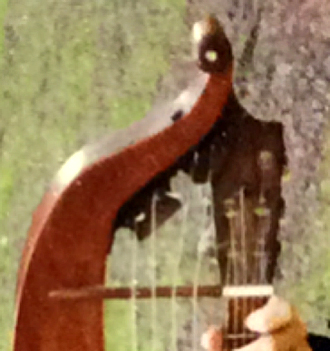
So, when Drew saw it, the bizarre, single 90-degree sub-bass tuner had been removed. Drew remembers the hole in the arm (it looks here like they had plugged it), but didn’t understand then what its purpose was.
As he noted, the original nut slot was still there. This photo from Don Adams shows it best:
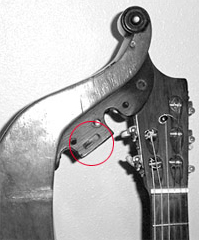
Interestingly then, the entire sub-bass array was probably fully original and intact when persons unknown decided to improve the design with the understandably more logical choice to add that long wooden bar as a new nut, spacing out the strings while allowing the four uniform friction tuners to better function (next image). The fifth through-the-arm tuner would only have remained problematic at best.
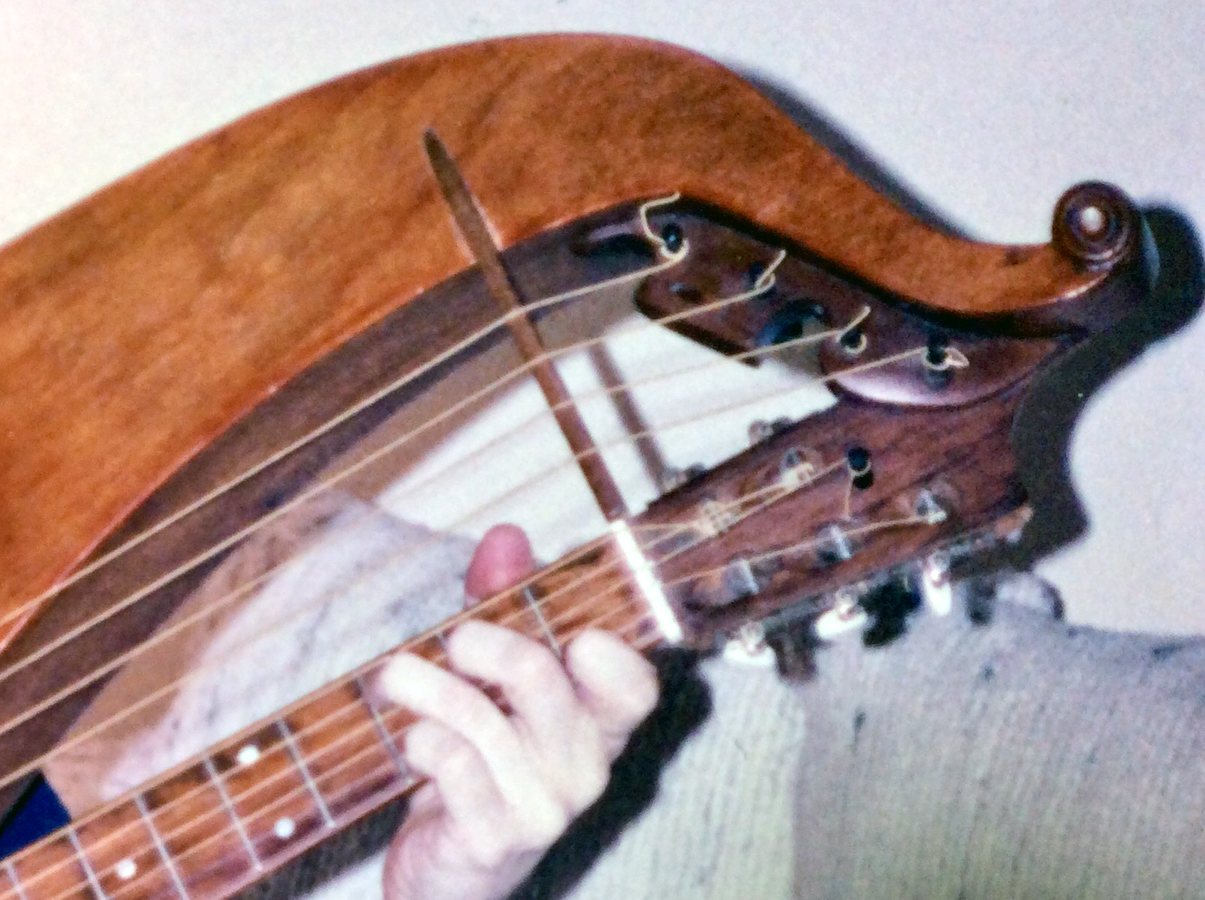
So, the top…
It is indeed curious. While Knutsen later used any available material for his instruments, including all sorts of reclaimed laminated furniture, he probably wasn’t doing that in this early period (nor Otto Anderson, even though he was additionally a cabinetmaker). The wood was rarely stained at this time while the finishes were a rich orange shellac.
But I was still weighing whether the top could have been original, with only the new bridge and bass nut being added, until I re-discovered this image from Don Adams:
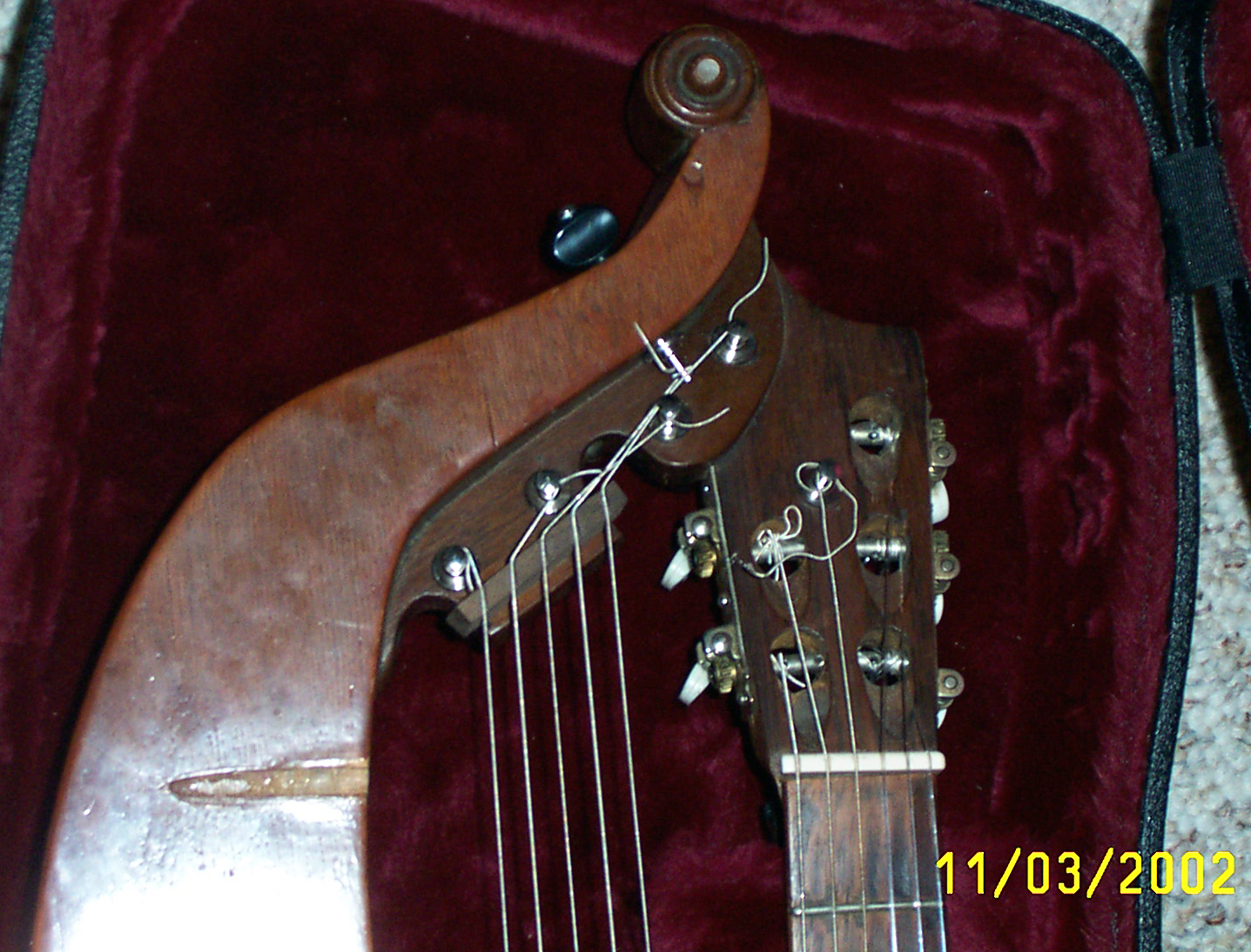
It shows the bar removed after final restoration (note now the replaced 5th bass tuner, new wooden nut and strings), and the wood underneath the old bar looks bare, or at minimum, missing the final finish. Thus, as Drew pointed out to me, the new nut bar may have been glued not to an original varnished top, but to a new bare top – after which the person applied the non-standard finish to the entire top and nut bar. That scenario does sound the most plausible. A final clue regarding the top is that the soundhole is noticeably larger than any of the other 1898 Patent Style specimens.
So, who did all this and when? I’ve seen several later modifications that Knutsen almost certainly did himself to his original instruments, but there’s no way to know – or real reason to think – that that’s the case here. Otherwise, I’d expect to have seen some transitional instruments built after this one that took this idea further, rather than the complete redesign of the bass head and tuner array. Regardless, it just doesn’t seem Knutsenesque to me. But what an interesting puzzle!
Epilogue:
As we all know, Bad Drew soon landed a 5-bass Dyer (and more recently a 6-bass), with which he’s entertained legions of unsuspecting patrons with his inimitable character and wit – including all who attended HGG7, 9, 10, 12, 13, 15 or 17 (below, performing his latest gem, “Procrastination.”).
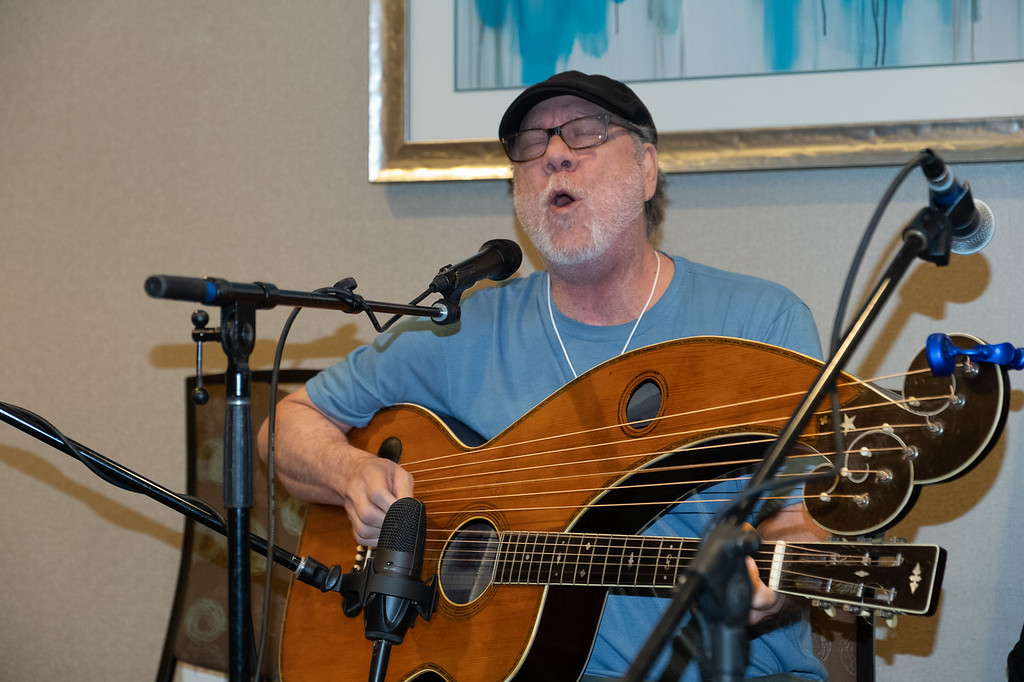
So, there you have it. Drew Baldwin: An important part of harp guitar player history, and now part of Knutsen harp guitar history!
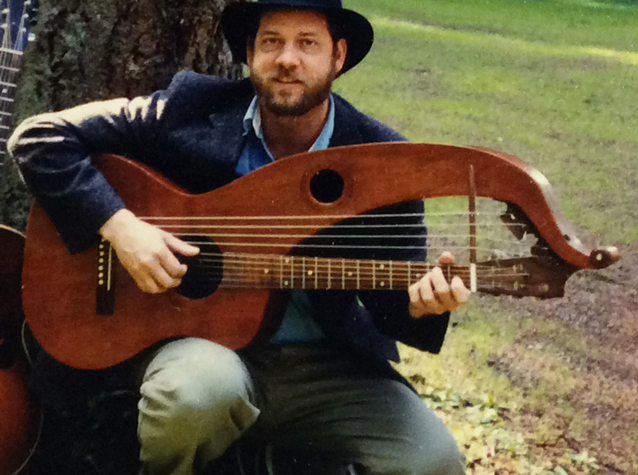
Drew with his first harp guitar – Knutsen Archives Inv #HGP8 – in the late 1980s.

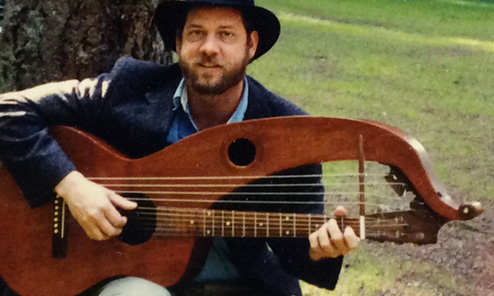
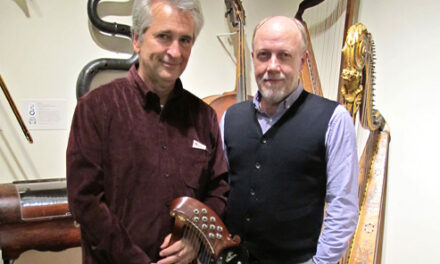
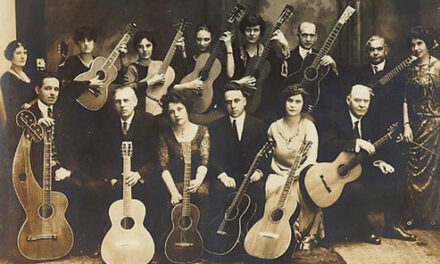

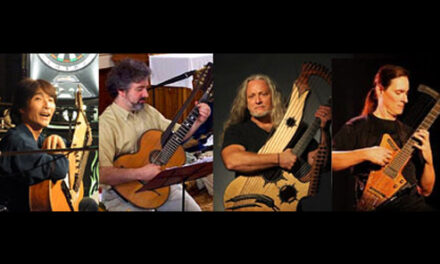
I think you totally nailed it Gregg! Thanks for shedding some light on what has been a mystery to me for many years. I still think this could possibly have been the original patent guitar, but a cool instrument nonetheless.
A very interesting exchange between you & Drew. The info & story are fascinating. Thanks Gregg.
Thanks for this article, Bad Drew is a national treasure.